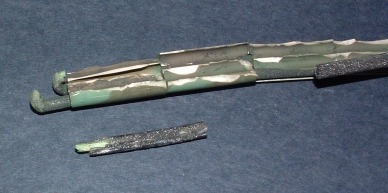
Green rot is most pronounced when type K thermocouples are exposed to temperatures between approximately 800°C and 1,260°C (1,472°F to 2,300°F) and when there’s a low concentration of oxygen. This problem causes negative drifts, inaccurate measurements, and even open circuits due to breakage caused by embrittlement. Applications where there is abundant oxygen supply or no oxygen at all, green rot does not occur.
Inexpensive, fast-responding, robust, and self-powered, industrial thermocouples are a top choice for temperature measurements and are widely used in many applications. Thermocouples comprise two wire conductors (legs) made of different metals (alloys), coming together at one end to create the measuring point (hot junction).
Thermocouples come in several types, designated by a letter. Each type has a different temperature-versus-EMF (electromotive force) characteristic due to the particular pairing of conductors. Some thermocouples are better in lower temperatures, while others do not even register much of an EMF until much higher temperatures.
The most commonly used thermocouple is type K, which works well within a broad temperature range – from between −200°C to 1,260°C (−328°F to 2,300°F). Its positive leg is made of a nickel-chromium (NiCr) alloy, while its negative leg is made of a nickel-aluminum (NiAl) alloy (ferromagnetic).
Although type K thermocouples are rugged and long lasting, they – like all thermocouples – lose accuracy with age and depending on their operating conditions. “Green rot” is one of the issues that can affect this general-purpose temperature measurement device.
What is Green Rot?

Example of green rot
Green rot is another name for the oxidation of chromium. It appears in high-temperature situations – typically between 800°C and 1,260°C (1,472°F and 2,300°F) – and when the process occurs in a low-oxygen environment. An oxide layer on the surface of the NiCr leg normally protects it from oxidizing. But in the presence of hydrogen or another reducing agent, chromium oxidation accelerates. The result is a layer of scaly green corrosion on the positive leg.
As oxidation eats away at the chromium, the normally non-magnetic NiCr leg becomes magnetic, causing a decrease in the thermoelectric voltage at the reference junction (cold junction). The greater the corrosion, the larger the negative voltage drift becomes, leading to significant temperature measurement errors. Green rot also makes the NiCr leg more brittle. If the corrosion is not checked, the positive leg can break, opening the circuit and rendering the device inoperable.
What to Do About Green Rot
Preventive measures can minimize the formation of green rot, thereby ensuring accurate temperature measurements and extending the lifetime of a type K thermocouple. These steps include:
- Cleaning and/or removing any reducing compounds from the inside of the thermocouple’s protection tube, or thermowell.
- Introducing additional oxygen to the thermowell.
- Introducing an inert gas to the thermowell.
- Incorporating a sacrificial oxygen-absorbing titanium conductor to the thermocouple.
- Using mineral-insulated (MI) sheathed cables.
These preventive measures can minimize – but not eliminate – the formation of chromium oxide. That is why type K thermocouples are best suited for applications in oxidizing or inert gas environments. For accurate temperature measurement in a low-oxygen environment, it may be better to use another type of thermocouple. For example, a type N thermocouple has a comparable range as a type K thermocouple, but its positive leg is made of a nickel-silicon alloy, and silicon adds a layer of protection from corrosion.
Thermocouples are an ideal temperature measurement solution. However, to avoid green rot and other issues, users should carefully choose the right ones for their applications. WIKA manufactures several lines of thermocouples. Contact WIKA’s specialists for expert advice on which thermocouple is the best choice for your application.

